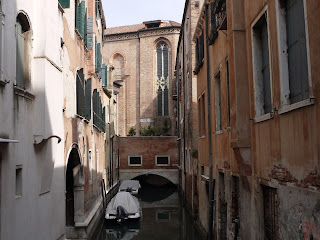Piazza San Marco
About the walk
Another impromptu walk. Like yesterday, we were sitting in Campo Santo Stefano having coffee and deciding what to do with the day. We decided to go the Rialto area to do some shopping. But rather than go there directly we thought we would take a scenic route via the Piazza San Marco. Thus we began a sort of anti-clockwise tour of the sestiere (district) of San Marco.
Crossing a small rio in the direction of San Marco we saw this wonderful view of the side of the church of Santo Stefano which demonstrates an extraordinary fact about the church - a small canal runs under it. Canals are everywhere in Venice, but this is a first.
We then made a short detour down to the edge of the Grand Canal to photograph one of the most striking palaces on it, the Palazzo Barbarigo. The owners were Murano glass blowers intent on bringing awareness of their product to a wider audience.
Back on the route towards San Marco, the Campo San Moritzio offers a view of the campanile of Santo Stefano which clearly reveals just how much it is leaning.
Once we reached Piazza San Marco (see the picture at the head of this post) we were struck by how much restoration is currently going on. The major works apparently are underpinning the campanile. This is probably a good idea since the existing campanile was built a hundred years ago as an exact replica of its predecessor which had collapsed.
Here is a nice detail of the facade of the cathedral.
We walked under the astronomical clock, which dates from 1497, ...
... and headed towards the Rialto. The main route is the Merceria. I spotted a very appealing jacket in the window as we passed by and so by the time we eventually reached Rialto, I no longer needed to doing any shopping. (This is of course a rather male approach to shopping; females know that shopping is not a zero-sum activity.)
We decided however to make a detour to see one of Venice less well-know sights, but one of our favourites, the exterior staircase of the Palazzo Contorini de Bovolo.
As we made our way finally towards the Rialto, we enjoyed this view from Calle del' Ovo of the narrow Rio del Salvador, full of gondolas, with the campanile of San Marco in the background.
Finally we emerged onto the side of the Grand Canal to enjoy a view of the wonderful Rialto bridge.
Max Mara beckoned and now it was time for some serious shopping.
Conditions: sunny, hot in the open, cool in the narrow streets
Distance: about 2.5 miles
Rating: four stars



























































